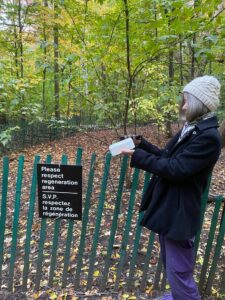Walking our way to better air quality
 By Claire MacDougall
By Claire MacDougallPoor air quality is a major tribulation facing urban life today, both for its impact on climate change and public health.
Blue skies are rare in many of the world’s largest cities. Citizens of densely populated and highly-motorised cities are surrounded by a haze of polluted air most days of the year while millions of people die from diseases caused by indoor and outdoor air pollution, such as heart disease, stroke, respiratory diseases and lung cancer.
While Ottawa’s air quality remains in the “ Very Good” to “Moderate” range most of the year, as the city expands and evolves; the future of clean air is in jeopardy.
One way to reduce air pollution in our city as the population grows and expands is to increase walkability. In addition to improving air quality, increased walkability also promotes personal and collective health in our communities by increasing active transportation.
“Walkability” of a neighbourhood measures whether community design encourages or inhibits walking. For example, a lack of sidewalks can make walking unsafe, and a disconnected street network can discourage walking in general. On the other hand, having retail stores close to where people live and providing connected streets increases the likelihood that a person will incorporate walking into daily routines. For example; people may choose to walk to the grocery store rather than drive if they have a safe and accessible path connecting their home and the store.
Increasing walkability is an effective way of reducing air pollution because a built environment which stimulates walking or biking rather than vehicular travel will decrease vehicle emissions. Simply put; people drive less and walk more in walkable communities which decreases vehicular emissions. Ottawa has room for improvement in terms of walkability. According to www.walkscore.com, Ottawa has a Walk Score of 45 indicating that most errands require a car.
A Seattle-based study found that increasing the walkability of residential neighbourhoods by 5% leads to each person driving 6.5 % fewer kilometres on average. This decrease in vehicular travel causes 5.5% fewer kilograms of traffic pollutants such as nitric oxide NO and Volatile Organic Compounds (VOCs) to be released into the environment.
Their results also indicated that the walkability index was significantly related to emissions that cause the formation of ozone, which impacts respiratory health. They concluded that people living in more walkable neighbourhoods did more walking and biking for transportation, had lower BMIs, drove less, and produced less air pollution than people living in less walkable neighbourhoods.
How do we increase the walkability of our neighbourhoods?
Increasing the walkability of our communities is closely related to urban planning and zoning/development laws. As citizens of Ottawa, we must advocate for policy and planning that prioritises pedestrian, bicycle and public transportation rather than automobile transportation.
Below are several aspects of the walkable communities policy from Walk Friendly Communities.Org More information can be found here.
-
More Complete Streets: Complete Streets are roadways that have been designed for safe and convenient transportation for everyone, not just cars! A complete street allows Pedestrians, bicyclists, motorists, and transit riders of all ages and abilities to use it safely. Complete streets include protected bike lanes or paved shoulders, sidewalks, crosswalks, median crossing islands, audible cues for people with low vision, pushbuttons which can be reached by people in wheelchairs, and curb cuts. Complete streets also feature public transportation accommodations such as bus shelters and dedicated bus lanes.
-
Transit system and Accessibility: Cities that are well served by transit can reduce automobile dependency. Providing people with the option to use an efficient and affordable transit system decreases the need to drive and own a vehicle.
-
Streetscape Design: Pedestrian amenities and urban design elements are essential for making walking comfortable and enjoyable. Street trees, lighting, benches, public art, and more can enhance the pedestrian experience, promoting more walking and improving safety.
-
Land Use Policies: Dense development rather than far-reaching suburbs is associated with higher levels of walking and transit use and reduced automobile dependency. To improve walkability; policymakers must create laws that encourage the development of affordable urban housing with access to public transit and reduce the development of sprawling suburbs and bedroom communities which require long daily commutes in a vehicle.
Air quality is an issue that will affect us all if we fail to address it. As citizens of Ottawa, we have the power to encourage changes in our cities and reduce pollution for future generations. Contact your local city councillor or Member of the Provincial Parliament to discuss how we can build the walkable communities of the future.
Mayor and City Councillors: https://ottawa.ca/en/city-hall/mayor-and-city-councillors(link is external)
Author : Claire MacDougall is a Master of Engineering Student and Atmospheric Science researcher where she has studied the Global Warming Potential (GWP) of atmospheric molecules Claire is a passionate advocate for design and programming that reduces chemical emissions. In her hometown of Antigonish, Nova Scotia, located in Mi’kma’ki, the ancestral and unceded territory of the Mi’kmaq People, Claire created an organisation that decreases emissions caused by plastic waste while addressing educational needs. Her project “The School Supplies Share Program” recycled lightly used school supplies and provided them to school-aged children experiencing poverty.
References
[1]Lisa Schweitzer & Jiangping Zhou (2010) Neighborhood Air Quality, Respiratory Health, and Vulnerable Populations in Compact and Sprawled Regions, Journal of the American Planning Association, 76:3, 363-371, DOI: 10.1080/01944363.2010.486623
[3] Marshall, J. D., Brauer, M., & Frank, L. D. (2009). Healthy neighbourhoods: walkability and air pollution. Environmental health perspectives, 117(11), 1752–1759. https://doi.org/10.1289/ehp.0900595
[5]Frank, Lawrence & Sallis, James & Conway, Terry & Chapman, James & Saelens, Brian & Bachman, William. (2006). Many Pathways from Land Use to Health: Associations between Neighborhood Walkability and Active Transportation, Body Mass Index, and Air Quality. Journal of the American Planning Association. 72. 75-87. 10.1080/01944360608976725.
[6]Scorza, F.; Fortunato, G.; Carbone, R.; Murgante, B.; Pontrandolfi, P. Increasing Urban Walkability through Citizens’ Participation Processes. Sustainability 2021, 13, 5835. https://doi.org/ 10.3390/su13115835
